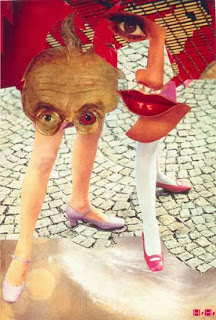I was taking three Art and Graphic Design classes this quarter, and there were several times that I encountered the words or ideas I've learned throughout this class. There was a time when Kent had mentioned about "Dada art movement" in the other GID class, I was reading Chapter 13 and learned about Dada the night before. Also there was a time I have to draw famous artist's artwork and write a paper about that artist. I was working on Renoir's artwork, and knew that he was one of the artists who lost his job as an artist by getting an affection of the Industrial Revolution. The knowledge I'd acquired in this class were really helpful in such a moment. Then I realized why this class is a requirement for my major and why it is important to understand the history of art.
There is one more thing that I'm thankful for this class. For a long time, I was thinking that everything related to art has its origin in Europe, and Europe developed "art." There are a lots of famous artists, sites, and museums in Europe. It might be true but I realized how narrow-minded I was after I read this textbook. Every countries all over the world has their own charms in art and something traditional. I'm a Japanese and I'm so proud of Japanese art, graphic design and architecture. This book made me realize that, therefore I did several research about Japanese Art nouveau and students in Bauhaus in past weeks. Now I'm thinking about going to Japanese Art College after I graduate from Foothill College.
As we all know, art and graphic design has been changing their form for centuries starting from Pre-Historic to Post Modernism. Every art movement has inherited the good parts of the old one and goes on. Now we are living in the century that has went through many past movement and it's such a fortunate that we have a lots of things we can learn and bring in to our modern arts and designs. I had mentioned about this for several times in past weeks, but I really hope those good old techniques and trend won't be forgotten. Because we are living in the high-technology society and it's really easy to relay on digital techniques rather than analog. I'd like to use both analog and digital techniques for my artworks by using knowledges I cultivated throughout this course.
As we all know, art and graphic design has been changing their form for centuries starting from Pre-Historic to Post Modernism. Every art movement has inherited the good parts of the old one and goes on. Now we are living in the century that has went through many past movement and it's such a fortunate that we have a lots of things we can learn and bring in to our modern arts and designs. I had mentioned about this for several times in past weeks, but I really hope those good old techniques and trend won't be forgotten. Because we are living in the high-technology society and it's really easy to relay on digital techniques rather than analog. I'd like to use both analog and digital techniques for my artworks by using knowledges I cultivated throughout this course.
Why I like art is that there are no boarder lines between countries. Why I came to the United States to study art is that there are many students from all over the world and I thought I can meet a new and different ideas and their unique characteristics in their artworks. It was really a great opportunity to learn and acquire what my peers research about and how they catch the concepts and ideas every week.




















